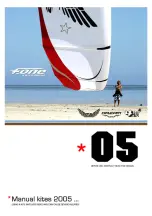
APAX evo user manual
________________________________________________________________________________________________________________________________________________________
Depending on the characteristics of your engine, once in the air you may be faced with a
torque effect. This may cause the wing to turn, so be prepared to counteract this effect with
suitable braking or anti-torque strap. If such a situation occurs during the climb-out with "slow"
trims and maximum power, be pay attention to the risk of stalling. Safe operations and
management of your engine depend on your knowledge and equipment.
Engine-induced oscillations
Certain configurations of weight, propeller diameter and engine power may cause serious
oscillations. The pilot is lifted to one side by the torque effect, swings down due to his weight
and is then lifted again and so on. To counter this effect:
●
change the throttle setting
●
counteract the pendulum movement with a slight brake input
●
adjust the trimmers to dampen the oscillation
These oscillations typically occur at full power. The greater the engine power and propeller
diameter, the greater will be the oscillations. In addition, late or inappropriate pilot reactions
may worsen the problem instead of solving it. Most inexperienced pilots tend to overreact,
leading to “pilot-induced” oscillations. In the majority of cases the best way to handle this is to
release the throttle and release the brakes.
In-flight characteristics
Cruising flight
Once you have reached a satisfactory altitude after take-off, you can turn in your chosen
direction, open the trimmers if they were previously in the "slow" configuration and go
“hands-up” on the brakes. If conditions are strong, you will need to fly actively.
For each paramotor, you must make an adjustment of the length of your brakes to prevent
them interfering with the propellers when you do release in flight.
If you have a vario or altimeter, keep an eye on it. In level flight, it is very easy to climb
unintentionally. The instruments exist to help you maximize your speed and fuel economy.
Naturally, the safety and success of each flight will depend on your piloting set-up, and thanks
to its ability to fly safely without constant piloting adjustments, the APAX evo will leave you all
the comfort to adjust everything properly.
Normal flight
“Trim speed” (brakes fully released) is the best glide speed in still air. The brake lines are
used to adjust the speed according to the flight situation in order to ensure optimum
performance and safety.
Minimum sink speed on the APAX evo is achieved by light braking. In a normal flying
position (knees parallel to the ground and your body slightly reclined), your hands should be
holding the brakes at a level between your eyes and your shoulders. Use this speed for
thermalling and ridge soaring.
Stall speed is approached by bringing your hands towards your hips. Notice the decreased
wind noise and a significant increase in brake pressure.
Page 18
Содержание APAX evo
Страница 1: ...User manual Version 1 0 Date August 2020...
Страница 52: ......
















































